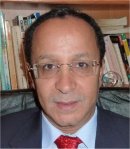|
Plenary Lecture
Novel Doped Bioactive Glass for Applications in
Orthopedic Surgery: In Vitro and in Vivo Bioactivity

Professor Hassane Oudadesse
University of Rennes 1, UMR CNRS 6226
263, Avenue du General Leclerc
35 042 Rennes Cedex, France
E-mail:
hassane.oudadesse@univ-rennes1.fr
Abstract: A bioactive glass
is an excellent candidate as a
graft for bone tissue
regeneration. The insertions of
atomic elements such as Zn, Sr
and/or Mg, separately or
simultaneously, present a high
interest in the bone metabolism
activity. They were introduced as
trace elements at different
contents in the glass matrix,
according to their concentration
in the bone matrix. Their effects
consist on the modification of
physico-chemical properties of
bioactive glass after "in vitro"
or "in vivo" experiments. Their
role is consequently the
improvement of the properties such
as crystallographic structure,
morphology and density of the
apatite layer formation on the
surfaces of biomaterials and the
bone-bonding ability. In this
work, bioactive glass in the
ternary system
(SiO2-CaO-Na2O-P2O5) was
elaborated by an original method
based on the melting process.
Additions of these atomic elements
have been made with different
amounts of each introduced element
in the glassy network.
In vitro experiments were achieved
to evaluate the crystallographic
structure, the morphology and the
kinetic of chemical reactivity
versus time of soaking in
synthetic physiological solution
(SBF). Cells adhesion and
proliferation on the surfaces of
biomaterials were investigated.
In vivo experiments were carried
out on the femurs of rabbits to
evaluate the biocompatibility, the
physico-chemical properties and
the kinetic of bioactivity and
bioconsolidation in the interface
bone-Implant. Several
physicochemical and biological
methods were employed to highlight
the behavior of pure and doped
bioactive glass.
Obtained results show different
behavior. The ppresence of
magnesium promotes the dissolution
of silica network when the
presence of strontium or zinc
slows down this phenomenon. All
doped bioactive glasses show the
no toxic character of these
biomaterials. However, the
introduction of strontium enhances
the cells proliferation of about
14.3 % compared to pure bioactive
glass.
In vivo experiments demonstrate
that 10% BG-Sr seem to be the best
implant materials tested leading
to beneficial effects in
stabilization of the oxidative
balance. These beneficial effects
were confirmed by histological
findings and correlated with the
biocompatibility of cells grown.
These biomaterials offer to
surgeons more opportunities.
Because of the variations of the
kinetic of bioactivity, they can
be adapted for patients according
to different parameters such as
the age, the gender, the location
site and other physiological
parameters.
Brief Biography of the Speaker:
Hassane Oudadesse graduated from
the University Blaise Pascal of
Clermont-Ferrand France. He
obtained his PhD in 1989 and
worked as associate Professor and
obtained his HDR (Habilitation a
Diriger des recherches) in 1998.
Since 2001, he works in the
University of Rennes 1 as Full
Professor in the "Sciences
Chimiques de Rennes", UMR CNRS
6226.
His works concern the conception,
synthesis and physicochemical
studies of new biomaterials for
applications in orthopaedic
surgery. Biocompatibility, kinetic
of bioactivity, kinetic of bio
consolidation in the interface
bone-Implants, cells enhancement
and other properties of
biomaterials present the research
filed of Professor Hassane
Oudadesse.
He is author of more than 80
articles published in
international journals and 50
international conferences.
Professor Hassane Oudadesse is a
Head of the research unit on
Biomaterials since 2001,
Vice-President of University of
Rennes 1, human resources since
2008, Director of Master 2 Solid
State Chemistry and Materials
since 2006. He was the President
of the Chemical Department from
2002 to 2004 and the President of
the specialists commission CNU 33
(Materials Chemistry) from 2003 to
2008.
|